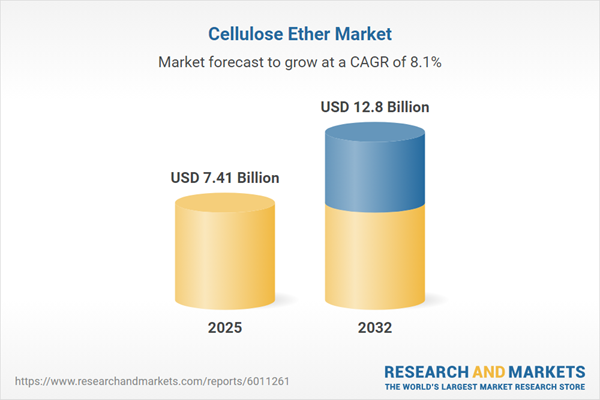Speak directly to the analyst to clarify any post sales queries you may have.
The cellulose ether market is undergoing rapid transformation, driven by technological advances, sustainability imperatives, and shifting global demand. Senior decision-makers face a dynamic landscape shaped by broader macroeconomic and regulatory trends, positioning cellulose ether as a key enabler in industrial performance and innovation across diverse sectors.
Market Snapshot: Cellulose Ether Market Size and Growth Outlook
The Cellulose Ether Market grew from USD 6.86 billion in 2024 to USD 7.41 billion in 2025. It is expected to continue growing at a CAGR of 8.11%, reaching USD 12.80 billion by 2032. This robust trajectory highlights the increasing role of cellulose ether in industrial, construction, pharmaceutical, and consumer applications worldwide as companies seek reliable, high-performance solutions tailored to their needs.
Scope & Segmentation: In-Depth Analysis of the Cellulose Ether Sector
This report covers market opportunities and trends with a clear focus on product development, regulatory shifts, and global consumption patterns. The market is dissected by various defining characteristics to support strategic planning:
- Product Type: Carboxymethyl Cellulose, Hydroxyethyl Cellulose, Hydroxypropyl Methylcellulose, Methylcellulose
- Physical Form: Powder, Granule, Flake (Coarse Flake, Fine Flake)
- Viscosity Grade: High Viscosity, Medium Viscosity, Low Viscosity
- Application: Construction (Mortar, Tile Adhesives), Food & Beverages, Oil & Gas, Personal Care, Pharmaceuticals
- Sales Channel: Direct Sales, Distributor Sales
- Regional Coverage: Americas (United States, Canada, Mexico, Brazil, Argentina, Chile, Colombia, Peru), Europe, Middle East & Africa (United Kingdom, Germany, France, Russia, Italy, Spain, Netherlands, Sweden, Poland, Switzerland, United Arab Emirates, Saudi Arabia, Qatar, Turkey, Israel, South Africa, Nigeria, Egypt, Kenya), Asia-Pacific (China, India, Japan, Australia, South Korea, Indonesia, Thailand, Malaysia, Singapore, Taiwan)
- Key Companies: The Dow Chemical Company, Ashland Global Holdings Inc., The Lubrizol Corporation, Shin-Etsu Chemical Co. Ltd., Akzo Nobel N.V., CP Kelco U.S. Inc., Merck KGaA, DFE Pharma N.V., Eastman Chemical Company, LOTTE Fine Chemical Co. Ltd.
Cellulose Ether Market: Key Segmentation Insights
Segmenting by chemistry and form enables tailored solutions for end-users, from high-viscosity construction additives to specialty food stabilizers. The breadth of sector application—ranging from pharmaceuticals to oil & gas—enables companies to diversify product strategies and reach target markets efficiently. Regional granularity underscores how local regulation and consumer trends dictate product adoption and innovation priorities.
Key Takeaways for Senior Decision-Makers
- Functional versatility and compliance with stringent regulations continue to make cellulose ethers foundational in both industrial and consumer product formulations.
- Technological innovation, including digitalization and green chemistry, is reshaping manufacturing workflows, driving efficiency, and supporting sustainability goals.
- Tariff changes, notably recent United States import tariffs, are leading to strategic shifts in sourcing, production localization, and supply chain risk management.
- An increasing preference for clean-label, eco-friendly solutions is emerging, particularly in food, personal care, and pharmaceuticals, spurring bio-based product development.
- Regional investment priorities—from infrastructure in the Americas to green economy initiatives in Europe and high-capacity manufacturing in Asia-Pacific—are recalibrating demand and supply strategies globally.
Tariff Impact: Navigating New Trade Dynamics
Recent United States tariffs in 2025 have prompted realignment in cellulose ether supply chains and procurement plans. Importers are diversifying sourcing across regions such as Asia-Pacific and Europe, while domestic manufacturers are optimizing efficiencies and investing in localizing production capabilities. These changes are fostering greater supplier ecosystem robustness and encouraging the adoption of flexible sourcing models designed to mitigate ongoing trade and geopolitical risks.
Methodology & Data Sources
This analysis utilizes a hybrid research approach, blending primary interviews with industry leaders and experts, alongside comprehensive secondary research and multi-layered validation. Insights are cross-checked through trade data, regulatory filings, and consultation with third-party analysts to ensure the highest level of accuracy and relevance for strategic decision-making.
Why This Report Matters: Strategic Value for Leadership
- Gain actionable intelligence on emerging production technologies, sustainability drivers, and evolving regulatory frameworks in the cellulose ether sector.
- Identify strategic growth opportunities across product segments, applications, and global regions, from new sourcing hotspots to premium market developments.
- Enhance supply chain resilience and innovation readiness with insights into best practices for risk mitigation, product development, and compliance alignment.
Conclusion: Forward-Looking Perspective on the Cellulose Ether Market
The cellulose ether market presents escalating opportunities—rooted in innovation, sustainability, and adaptive strategy—for companies aiming to realize resilient growth. This report equips leaders with the insights needed to navigate market complexities and capture value in a changing industrial landscape.
Additional Product Information:
- Purchase of this report includes 1 year online access with quarterly updates.
- This report can be updated on request. Please contact our Customer Experience team using the Ask a Question widget on our website.
Table of Contents
3. Executive Summary
4. Market Overview
7. Cumulative Impact of Artificial Intelligence 2025
Companies Mentioned
The companies profiled in this Cellulose Ether market report include:- The Dow Chemical Company
- Ashland Global Holdings Inc.
- The Lubrizol Corporation
- Shin-Etsu Chemical Co., Ltd.
- Akzo Nobel N.V.
- CP Kelco U.S., Inc.
- Merck KGaA
- DFE Pharma N.V.
- Eastman Chemical Company
- LOTTE Fine Chemical Co., Ltd.
Table Information
| Report Attribute | Details |
|---|---|
| No. of Pages | 191 |
| Published | October 2025 |
| Forecast Period | 2025 - 2032 |
| Estimated Market Value ( USD | $ 7.41 Billion |
| Forecasted Market Value ( USD | $ 12.8 Billion |
| Compound Annual Growth Rate | 8.1% |
| Regions Covered | Global |
| No. of Companies Mentioned | 11 |









